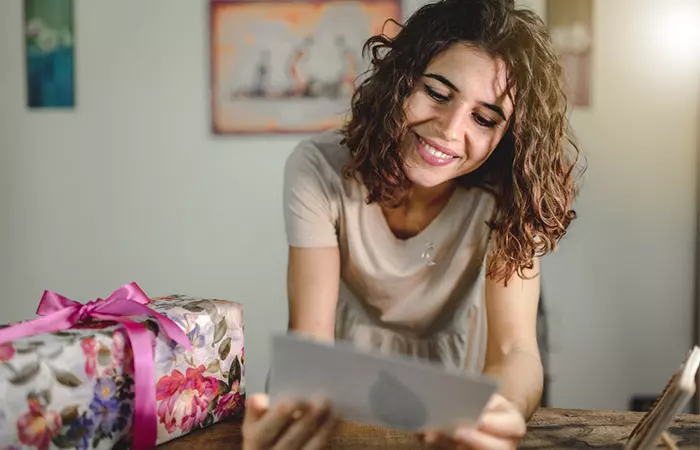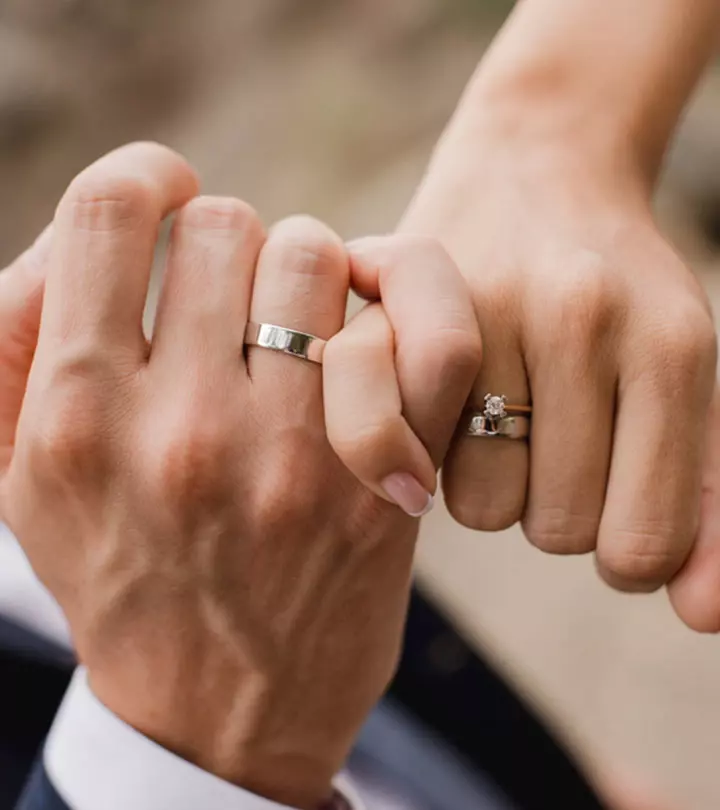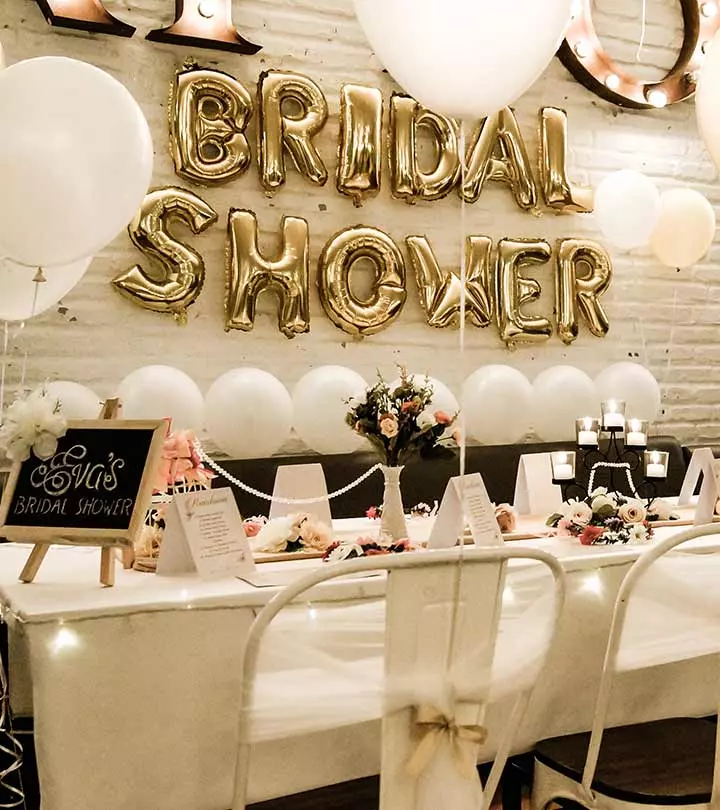How To Address Wedding Invitations: 8 Essential Etiquette Tips
Add your personal touch to every word to make it memorable for you and your guests.

Image: Shutterstock
Today, people like to go all out with creativity to make wedding invitations stand out in the crowd. In addition to the aesthetics of the, knowing how to address wedding invitations is super, super important. Because, no matter how unique or cute these cards are, if the content is not understandable and its tone is not humble, then investing so much on the card’s appearance only turns out to be a waste of time, effort, and money! Keeping this in mind, we have taken the responsibility to teach you how to properly address wedding invitations in this article so that you can just focus on the creative side of things and the other essential aspects of your D-day. All you have to do is scroll down and get all the deets.
In This Article
How To Address Wedding Invitations Properly?
So, we are now aware of how important it is to follow specific guidelines when it comes to addressing wedding invites. Below are some etiquette tips that you will need to keep in mind. From explaining to you how to address doctors on wedding invitations to showing you how to write out addresses on wedding invitations, we have covered it all.
- Avoid using abbreviations, except for Mrs. Mr. or Ms.
- Avoid using symbols.
- Always spell out the word “and”.
- Stay away from using initials.
- If you are unsure about the spelling of the guest’s name or address, just ask them; it’s okay!
- It is not mandatory to mention the middle names; if you want to, then make sure to spell it out instead of abbreviating it.
- Write out the professional titles such as Professor or Doctor.
- Spell out state names too. Do not abbreviate them.
 Quick Tip
Quick TipNow, check what goes into the two envelopes required in the invitation cards:
The Inner Envelope: The inner envelope will hold the invitation suite. It will include the names of all the people who will be invited. So, this is where you have to make sure you are thorough with who you are going to invite. This envelope will not have any address printed on it.
The Outer Envelope: The outer envelope, which is also called the mailing envelope, will hold the inner envelope, and it will be addressed formally. The heads of the family’s names and their titles should be mentioned here, and underneath should be the mailing address.
Examples Of How To Address Wedding Invitations
Honestly, tons of things go into making a lovely wedding invitation. Addressing the guest list might look simple, but it isn’t. It gets complicated because you will be inviting people who have different family situations. While some will be married, others will be unmarried; some might have a date you want them to bring as a plus one, some might have close friends and kids. Below, we have made your task easier by explaining how to address wedding invitations to a family, how to address informal wedding invitations and more. Now, let us dive deep into understanding how to address the invitations based on the family situations through the following examples.
To Invite Opposite Sex Married Couple With Same Surnames
If you want to go all formal and traditional, follow the wedding etiquette. Try this, for example, Mr. and Mrs. Jack Williams” or “Mrs. and Mr. Jack Williams” or “Mr. and Mrs. Rachel Williams” or “Mrs. and Mr. Rachel Williams. Also, you can list both the names of the couple. Try “ Mr. Jack and Mrs. Rachel Williams,” or “Mrs. Rachel and Mr. Jack Williams”. But if you want to have a casual vibe in the card, you can let go of the surname. For instance: “Jack and Rachel”.
To Invite Opposite Sex Married Couple With Different Surnames
To invite a married couple who do not share the same surnames, you will need to follow the same protocol mentioned above, but this time, you will add the respective last names for formal invitations or only the first names for informal ones. For example: “Mrs. Rachel Williams and Mr. Jack Truscott” or “Mr. Jack Truscott and Mrs. Rachel Williams” or “Mr. Truscott and Mrs. Williams” or “Mrs. Williams and Mr. Truscott” or just ‘Rachel and Jack” or “Jack and Rachel”.
To Invite Same-Sex Married Couple With Same Surnames
Let us now see how to address same-sex couples on a wedding invitation. So, here you mention both the names of the duo. Deciding which name goes first shouldn’t be difficult because you can arrange the names alphabetically. For gays, try “The Messrs. Jack and Joe Truscott” or “The Messrs. Joe and Jack Truscott”. And for lesbians, it goes “The Mesdames Rachel and Lucy Williams” or “The Mesdames Lucy and Rachel Williams”.
To Invite Same-Sex Married Couple With Different Surnames
If the couple does not share a common surname, mention both the first and last names of the couple. Somewhat like this for gays: “Mr. Jack Williams and Mr. Joe Truscott” or “Mr. Joe Truscott and Mr. Jack Williams”. For lesbians: “Mrs. Rachel Williams and Mrs. Lucy Truscott” or “Mrs. Lucy Truscott and Mrs. Rachel Williams”.
To Invite Opposite Sex Unmarried Couple
How to address wedding invites with plus one? It’s simple. If the couple lives together, mention both the names with the appropriate titles. The order doesn’t matter; you can just arrange them alphabetically. For instance: “Mr. Jack Truscott and Ms. Rachel Williams” or “Ms. Rachel Williams and Mr. Jack Truscott”.
If they don’t live together, you can just address them just like you would do to a single girl or a guy without mentioning the plus one. For example: “Ms. Rachel Williams” for the woman and “Mr. Jack Truscott” for the man.
To Invite Same-Sex Unmarried Couple
The protocol here is also just like it is for the opposite sex unmarried couple if they live together. Only the title differs. For example: “Mr. Joe Truscott and Mr. Jack Williams” or “Mr. Jack Williams and Mr. Joe Truscott” for men and “Mrs. Rachel Williams and Mrs. Lucy Truscott” or “ Mrs. Lucy Truscott and Mrs. Rachel Williams” for women.
When the couple doesn’t live together, you can send them separate invitations just like you would to a single guest. Don’t mention the plus one here either.
To A Single Female
How to address a single woman on a wedding invitation. Well, you can use “Ms” if she is over 18 years old. If she is below 18, you can use “Miss”.
For example, Ms. Rachel Williams (if she is over 18 years old) or Miss Rachel Williams
(if she is not 18 yet).
To A Single Male
While inviting a single male guest, use “Mr” before the name if he is above 18. If below, then no title is required. For example: “Mr. Joe Truscott” for males above 18 and only
“Jack Truscott” for the ones below 18.
To Invite A Family With Kids
Now, let us learn how to address wedding invitations with kids. You need to help the guests know if kids are invited too. If they are, then make it specific in the card. While listing the kids’ names, order them from oldest to youngest.
For example:
For families that have parents of the opposite sex and share a common surname:
“Mrs. Rachel Williams and Mr. Jack Williams
Lilly, Susan and Mike”
or
“Mr. Jack Williams and Mrs. Rachel Williams
Lilly, Susan and Mike”
For families that have parents of the opposite sex and don’t share a common surname:
“Mrs. Rachel Williams and Mr. Jack Truscott
Lilly, Susan and Mike”
or
“Mr. Jack Truscott and Mrs. Rachel Williams
Lilly, Susan and Mike”
For families that have parents of the same sex and share a common surname:
Lesbian parents: “Mrs. Rachel Williams and Mrs. Lucy Truscott
Lilly, Susan and Mike”
or
“Mrs. Lucy Truscott and Mrs. Rachel Williams
Lilly, Susan and Mike”
Gay parents:
“Mr. Joe Truscott and Mr. Jack Williams
Lilly, Susan and Mike”
or
“Mr. Jack Williams and Joe Truscott
Lilly, Susan and Mike”
To Invite A Plus One
If you want to invite a guest with a plus one, get inspired by this: “Ms. William and guest”. This has a pleasant tone and sounds better than addressing as “plus one”. However, this is mentioned only in the inner envelope. You can simply mention “Ms. Rachel Williams” in the outer one along with the mailing address.
 Quick Tip
Quick TipWith this, we conclude our article on how to address wedding invitations. The aforementioned tips and examples should make your task easier than ever before. Although it can be a complicated process, producing the best invitation cards is fun too. So, always make sure you have the best wedding stationery and are full of joy when you do it. After all, it’s a wedding knocking at the door. And once you have accomplished this invitation card task, you are very much close to beginning your D-day celebrations! Hurray!
Frequently Asked Questions
Why does the bride’s name go first on wedding invitations?
A bride’s name usually goes first on a wedding invitation because traditionally, the bride’s family invites for and makes all arrangements for the wedding.
Is it okay to handwrite addresses on wedding invitations?
Yes, it adds a personal touch to the invitations and is generally more appreciated. However, it also depends on the number of guests, your personal connections, and the time and bandwidth you have for the same. If you don’t handwrite them, please make sure to use a clear and proper font. Stay away from the funky ones.
Is it too early to send wedding invites 6 months in advance?
While you can choose to send the “save the date” cards 4-6 months ahead of the wedding, you should send the actual invitations closer in time to the wedding.
Is it okay not to bring a gift to a wedding?
It is not mandatory and is ultimately up to you and your personal relationship to decide whether you should take a gift to the wedding. Also, some couples may choose to request a “no-gift” wedding event.
Key Takeaways
- You shouldn’t use abbreviations apart from Mrs., Mr., or Ms., and avoid including initials and symbols. Nevertheless, you should always add professional titles like Doctor or Professor.
- The inner envelope of your wedding invitation holds the invitation suite and contains the names of all the invited guests.
- The outer envelope or the mailing envelope will include the inner envelope and will be addressed formally.
- If kids are invited to your wedding, you will have to specifically state so in the card. You can do this by writing their names from oldest to youngest.
- If you are inviting guests with a plus one, then you can add “and guest” or “plus one” after their name.
Don’t know how to properly address your wedding invitations? Check out this video to learn about the dos and don’ts and make a lasting impression on your guests.
Read full bio of Jeff Lanno
Read full bio of Shivani Chandel
Read full bio of Asmita De
Read full bio of Sneha Tete



































Community Experiences
Join the conversation and become a part of our empowering community! Share your stories, experiences, and insights to connect with other beauty, lifestyle, and health enthusiasts.